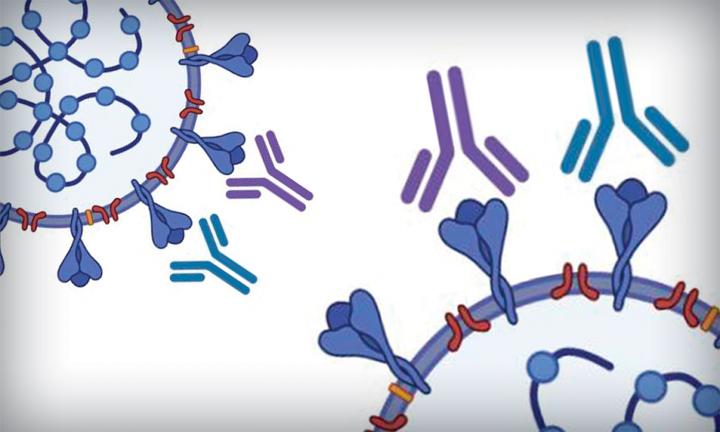In collaboration with UT Austin, Penn State University and the U.S. Army Medical Research Institute of Infectious Diseases (USAMRIID), study authors used the new test to evaluate 2,814 blood samples used in an ongoing study of convalescent plasma therapy.
An antibody test for the virus that causes COVID-19, developed by researchers at The University of Texas at Austin in collaboration with Houston Methodist and other institutions, is more accurate and can handle a much larger number of donor samples at lower overall cost than standard antibody tests currently in use. In the near term, the test can be used to accurately identify the best donors for convalescent plasma therapy and measure how well candidate vaccines and other therapies elicit an immune response.
Additional uses coming later that are likely to have the biggest societal impact, the researchers say, are to assess relative immunity in those previously infected by the SARS-CoV-2 virus and identify asymptomatic individuals with high levels of neutralizing antibodies against the virus.
The UT Austin research team, led by Jason Lavinder, a research associate in the Cockrell School of Engineering, and Greg Ippolito, assistant professor in the College of Natural Sciences and Dell Medical School, developed the new antibody test for SARS-CoV-2 and provided the viral antigens for this study via their UT Austin colleague and collaborator, associate professor Jason McLellan. Other UT Austin team members are Dalton Towers and Jimmy Gollihar. The work was published this week in The Journal of Clinical Investigation.
“This is potentially game-changing when it comes to serological testing for COVID-19 immunity,” Lavinder said. “We can now use highly scalable, automated testing to examine antibody-based immunity to COVID-19 for hundreds of donors in a single run. With increased levels of automation, limited capacity for serological testing can be rapidly addressed using this approach.”
The gold standard of COVID-19 antibody testing measures the amount of virus neutralizing (VN) antibodies circulating in the blood, because this closely correlates with immunity. However, this kind of antibody testing is not widely available because it’s technically complex; requires days to set up, run and interpret; and needs to be performed in a biosafety level 3 laboratory.
The research team, therefore, looked to another type of test, called ELISA assays, that can be implemented and performed with relative ease in a high-throughput fashion and are widely available and extensively used in clinical labs across the world. The ELISA tests, or enzyme-linked immunosorbent assays, look at whether antibodies against specific SARS-CoV-2 proteins are present and produce a quantitative measure of those antibodies.
The goal of the study was to test the hypothesis that levels of antibodies that target two regions of the virus’s spike protein–spike ectodomain (ECD) and receptor binding domain (RBD)–are correlated with virus neutralizing antibody levels, making these more accessible, easier-to-perform ELISA tests a surrogate marker to identify plasma donors with antibody levels above the recommended U.S. Food and Drug Administration threshold for convalescent plasma donation.
In collaboration with UT Austin, Penn State University and the U.S. Army Medical Research Institute of Infectious Diseases (USAMRIID), study authors James M. Musser, M.D., Ph.D., and Eric Salazar, M.D., Ph.D., physician scientists at Houston Methodist, used the new test to evaluate 2,814 blood samples used in an ongoing study of convalescent plasma therapy. Houston Methodist became the first academic medical center in the nation to transfuse plasma from recovered individuals into COVID-19 patients.
The researchers found that the ELISA tests had an 80% probability or greater of comparable antibody level to VN levels at or above the FDA-recommended levels for COVID-19 convalescent plasma. These results affirm that all three types of tests could potentially serve as a quantitative target for therapeutic and prophylactic treatments.
Ultimately, the study successfully concluded that anti-RBD or anti-ECD antibody levels can serve as a surrogate for VN levels to identify suitable plasma donors and that these alternate ELISA tests may provide critical information about COVID-19 immunity.
“This research required a perfect storm at the university, which included the extraordinary combination of a world-famous coronavirus structural biology lab, a nimble and passionate visiting army scientist, and the highest echelons of the university’s administration who were committed to bringing our extensive research programs to bear on the COVID-19 crisis,” Ippolito said.
This study was supported by funding from the National Institutes of Health, the Fondren Foundation, the National Institute of Allergy and Infectious Diseases (NIAID), the Army Research Office (ARO), Houston Methodist Hospital, Houston Methodist Infectious Diseases Research Fund, Houston Methodist Research Institute and seed funding from the Huck Institutes of the Life Sciences for the studies at Penn State, together with the Huck Distinguished Chair in Global Health award. Funding was also provided through the CARES Act, with programmatic oversight from the Military Infectious Diseases Research Program.
Convalescent plasma anti-SARS-CoV-2 spike protein ectodomain and receptor binding domain IgG correlate with virus neutralization. The Journal of Clinical Investigation, September 10, 2020.


